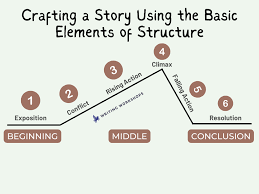Unveiling the Intricacies of Story Structure

The Importance of Story Structure
Story structure is the backbone of any narrative, providing a framework that guides the audience through the unfolding events. A well-crafted story structure not only captivates the reader or viewer but also ensures coherence and impact in storytelling.
One of the key elements of story structure is the introduction, where characters, setting, and initial conflicts are established. This sets the stage for what is to come and draws the audience into the world of the story. The rising action follows, building tension and escalating conflicts as the plot unfolds.
The climax is a pivotal moment in the story where tensions reach their peak, leading to a turning point that propels the narrative towards resolution. This is followed by the falling action, where loose ends are tied up, and consequences are revealed.
Finally, the resolution brings closure to the story, providing a sense of completion and allowing readers or viewers to reflect on the journey they have been taken on. A well-structured story leaves a lasting impact and lingers in the minds of its audience long after it has ended.
Whether it’s a novel, a film, or a play, mastering story structure is essential for creating engaging and impactful narratives. By understanding how to craft compelling introductions, build tension through rising action, deliver powerful climaxes, and provide satisfying resolutions, storytellers can capture hearts and minds with their tales.
Mastering Story Structure: Five Essential Tips for Engaging Narratives
- Introduce your main characters and establish the setting early on to engage the reader.
- Build tension and conflict to keep the story engaging and drive the plot forward.
- Include a clear beginning, middle, and end to provide structure and coherence to your narrative.
- Ensure that each scene or chapter contributes to the overall story arc and character development.
- Consider using flashbacks or foreshadowing techniques to add depth and complexity to your storytelling.
Introduce your main characters and establish the setting early on to engage the reader.
To create a compelling narrative, it is crucial to introduce your main characters and establish the setting early on in the story. By doing so, you not only provide the audience with a clear understanding of who they will be following throughout the narrative but also immerse them in the world you have crafted. This early engagement hooks the reader’s interest and sets the stage for the unfolding events, laying a solid foundation for a captivating storytelling experience.
Build tension and conflict to keep the story engaging and drive the plot forward.
To create a compelling narrative, it is crucial to build tension and conflict throughout the story. By introducing obstacles, challenges, and dilemmas for the characters to overcome, the plot is propelled forward, keeping the audience engaged and invested in the outcome. Tension serves as a driving force that heightens emotions, sustains interest, and ultimately leads to a more satisfying resolution. Through skillful manipulation of conflict, storytellers can craft a dynamic and riveting tale that captivates readers or viewers from beginning to end.
Include a clear beginning, middle, and end to provide structure and coherence to your narrative.
To craft a compelling narrative, it is essential to incorporate a clear beginning, middle, and end in your story structure. The beginning sets the stage by introducing characters, settings, and conflicts, drawing the audience into the narrative. The middle builds upon this foundation, developing tension and escalating events to keep the audience engaged. Finally, the end offers resolution and closure, allowing readers or viewers to reflect on the journey they have experienced. By adhering to this structure, storytellers can create a cohesive and impactful narrative that resonates with their audience.
Ensure that each scene or chapter contributes to the overall story arc and character development.
It is crucial to ensure that each scene or chapter in a story contributes meaningfully to the overall narrative arc and character development. By carefully crafting scenes that advance the plot, reveal new insights about the characters, or drive the story towards its resolution, writers can maintain a sense of cohesion and purpose throughout their work. Every scene should serve a specific function, whether it is to develop relationships between characters, introduce key conflicts, or showcase important moments of growth. This approach not only keeps the story focused and engaging but also allows for a deeper exploration of the characters’ journeys and motivations, ultimately enriching the overall storytelling experience.
Consider using flashbacks or foreshadowing techniques to add depth and complexity to your storytelling.
When crafting a story, incorporating flashbacks or foreshadowing techniques can elevate the narrative by adding layers of depth and complexity. Flashbacks provide insights into characters’ pasts, motivations, and relationships, enriching the present storyline with context and emotional resonance. On the other hand, foreshadowing subtly hints at future events, creating anticipation and intrigue for the audience. By judiciously employing these techniques, storytellers can enhance their storytelling by weaving a more intricate and engaging tapestry of events that captivate readers or viewers.
Tags: audience, challenges, characters, climax, closure, coherence, completion, conflicts, dilemmas, driving force, emotions, engaging narratives, film, framework, impact, importance, introduction, narrative, novel, obstacles, play, resolution, rising action, satisfying resolution, setting, story structure, tension